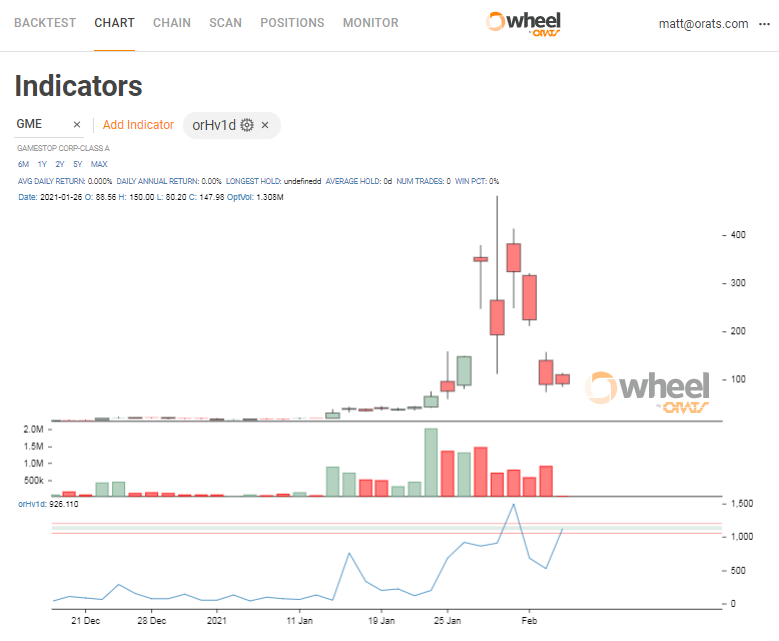Market Events
Wednesday, February 3rd 2021
GameStop Puts In Demand And The Importance Of Put Spreads. Reuters Quotes Matt Amberson.
Puts have been the star of options trading in GameStop lately but straight puts with high implied volatility can be problematic.
Summary
GameStop puts have been in high demand due to the difficulty of shorting a stock with over 100% of the stock shorted. However, buying straight puts with high implied volatility can severely cut into profits even if the stock moves in the desired direction. A put spread can help mitigate this issue, as it reduces the impact of vega, an options greek that reflects the sensitivity of options price to a move in implied volatility.
GameStop puts traded 250% more than calls yesterday on a bad day for the stock price, closing at $90 down 60%. The open interest on puts outnumber calls by 600%.
Why? My thoughts, as I was quoted by Reuters article here, “People are putting on puts in order to profit from the eventual GameStop short squeeze to be over." Since those people find it very difficult if not impossible to short a stock that has over 100% of the stock shorted, the use of puts are a natural answer.
However, the implied volatility has been astronomically high as I blogged about here:
Put buyers have found out the hard way that buying straight puts at these implied volatility levels can severely cut into profits even if the stock goes your way.
For example as @mark_down pointed out on Twitter, with the stock at $320 Friday, let's say you bought the $25 strike puts for $5.50 with a March expiry. Today, with the stock at $100 those same puts are trading $4.50. You would be down 20% on your puts with the stock moving your way down 70%.
The reason for this anomaly is that implied volatility moved against you. A put spread would have helped but still there is vega in a long put spread, and the vega is why you lost so much. Vega is an options greek that reflects the sensitivity of the options price to a move in implied volatility.
Alternatively, you could have bought a 40/25 put spread for about the same price as a 25 put on Friday. Today that put spread is worth $7.00. At least you'd be 35% profitable.
How do you know if implied volatility is "astronomically high"?
One way is to look at the actual volatility or as it is also known the historical volatility (HV). ORATS uses a modification of HV know as the Parkinson method that uses the high and low prices of the stock to formulate a reading. This method has the advantage over traditional close to close methods of measuring volatility that a one-day vol can be obtained. Below is a graph of the one-day ORATS HV.

Looking at that graph, you can see why the IV got up to 1000%. However, volatility is often short lived and mean reverting. Don't expect GME to be this crazy too long.
Disclaimer:
The opinions and ideas presented herein are for informational and educational purposes only and should not be construed to represent trading or investment advice tailored to your investment objectives. You should not rely solely on any content herein and we strongly encourage you to discuss any trades or investments with your broker or investment adviser, prior to execution. None of the information contained herein constitutes a recommendation that any particular security, portfolio, transaction, or investment strategy is suitable for any specific person. Option trading and investing involves risk and is not suitable for all investors.
All opinions are based upon information and systems considered reliable, but we do not warrant the completeness or accuracy, and such information should not be relied upon as such. We are under no obligation to update or correct any information herein. All statements and opinions are subject to change without notice.
Past performance is not indicative of future results. We do not, will not and cannot guarantee any specific outcome or profit. All traders and investors must be aware of the real risk of loss in following any strategy or investment discussed herein.
Owners, employees, directors, shareholders, officers, agents or representatives of ORATS may have interests or positions in securities of any company profiled herein. Specifically, such individuals or entities may buy or sell positions, and may or may not follow the information provided herein. Some or all of the positions may have been acquired prior to the publication of such information, and such positions may increase or decrease at any time. Any opinions expressed and/or information are statements of judgment as of the date of publication only.
Day trading, short term trading, options trading, and futures trading are extremely risky undertakings. They generally are not appropriate for someone with limited capital, little or no trading experience, and/ or a low tolerance for risk. Never execute a trade unless you can afford to and are prepared to lose your entire investment. In addition, certain trades may result in a loss greater than your entire investment. Always perform your own due diligence and, as appropriate, make informed decisions with the help of a licensed financial professional.
Commissions, fees and other costs associated with investing or trading may vary from broker to broker. All investors and traders are advised to speak with their stock broker or investment adviser about these costs. Be aware that certain trades that may be profitable for some may not be profitable for others, after taking into account these costs. In certain markets, investors and traders may not always be able to buy or sell a position at the price discussed, and consequently not be able to take advantage of certain trades discussed herein.
Be sure to read the OCCs Characteristics and Risks of Standardized Options to learn more about options trading.
Related Posts



